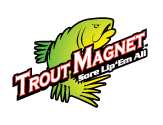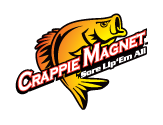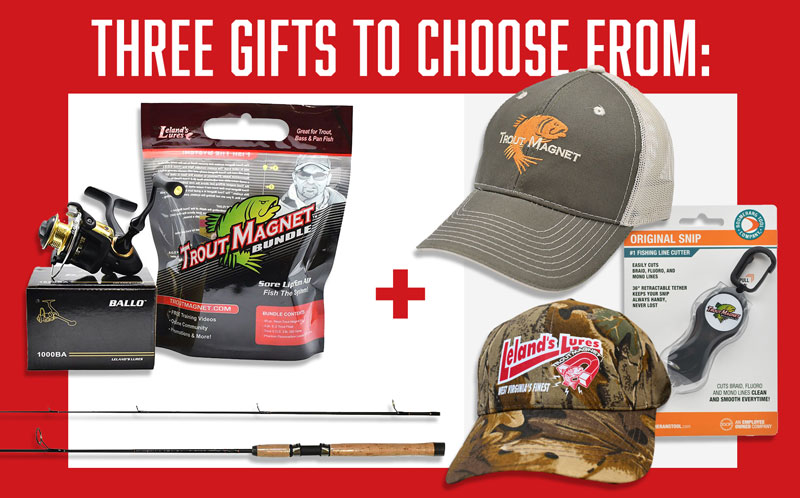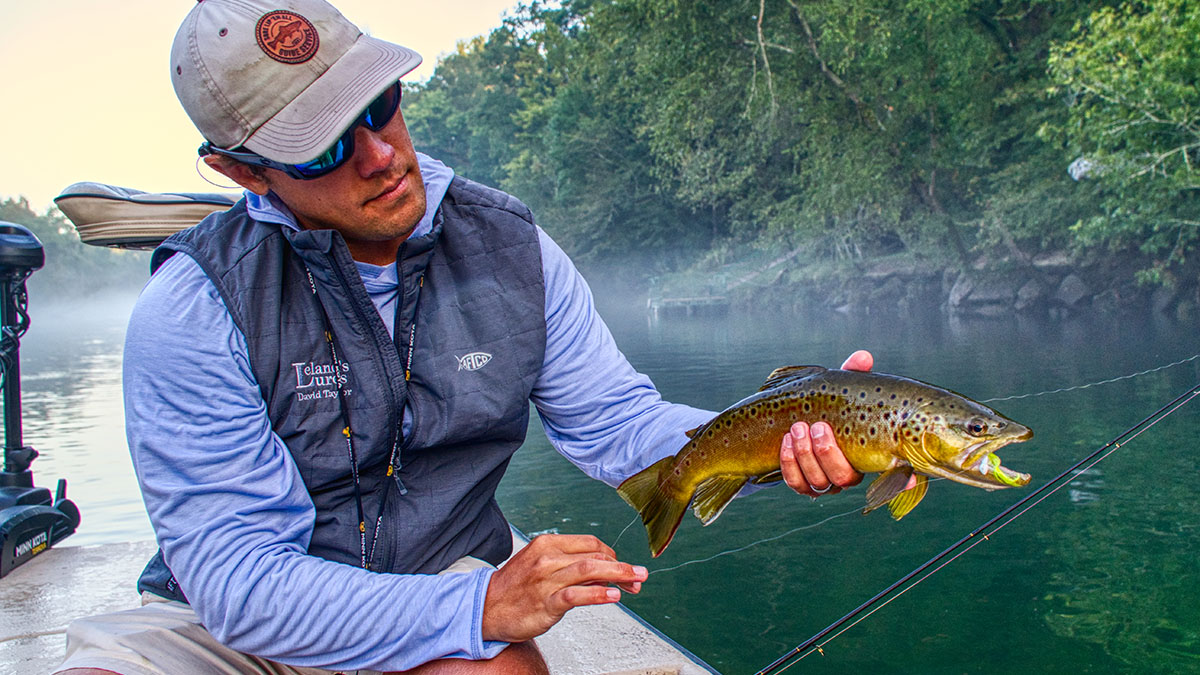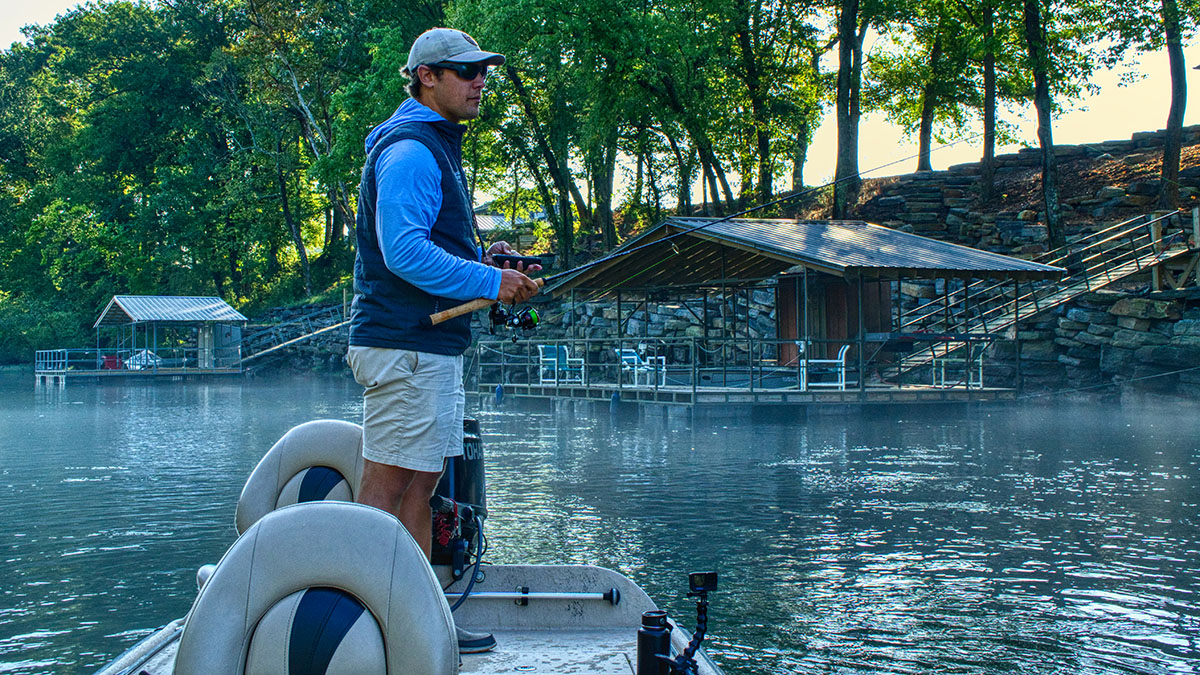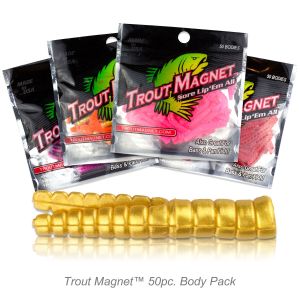Trout fishing not only offers exciting opportunities in beautiful locations, but they are more plentiful than many anglers realize with millions of trout stocked annually across the United States. There is phenomenal trout fishing worldwide from Australia and New Zealand to Japan, Argentina, Iceland and more. The various species of trout offer incredible action, lots of beautiful fish in even more beautiful locales which makes them a prized catch for all anglers.
But getting started in trout fishing can be daunting when you start looking at all the tackle and gear, different fisheries and all the various ways to fish for them. It can seem overwhelming, but really a very simple system that encompasses simple gear and simple approaches for maximizing your time on the water can make trout fishing easier to quickly learn with lots of action and memories made.
This guide will cover the following facets of trout fishing:
- Where to fish for trout
- Recommended fishing gear
- Best lures for trout fishing
- Simple techniques for trout
- Other things you should know before trout fishing
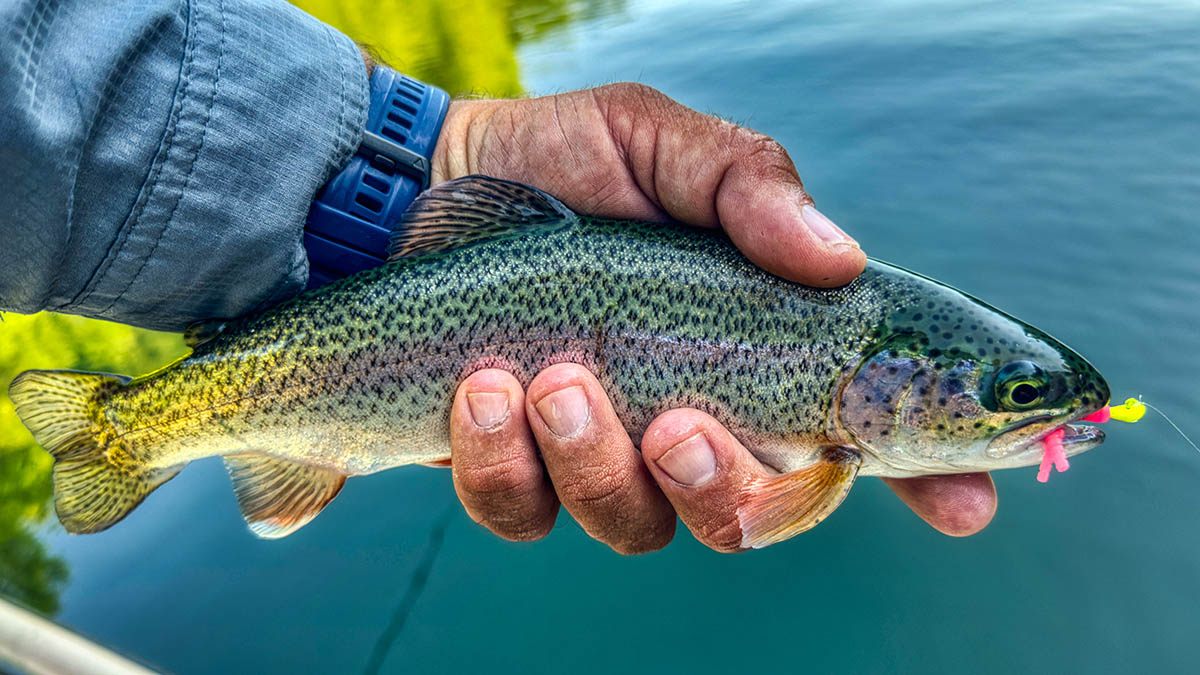
Where to Fish for Trout
Cold water. Seriously speaking, everything to do with trout fishing revolves around colder waters. Most trout prefer waters colder than 65 degrees, and water below 60 degrees is even better. They are a cold water species, so you are looking for waters that are colder than most freshwater lakes.
Cold water is created by several different factors.
Elevation is often where you find good trout waters. Waters flowing out of snow covered mountains tend to be colder. But even still, water flowing from higher elevations will be much colder than waters at sea level. Most of the streams out west are created naturally by snow runoff in the spring and waters coming down mountains from much higher elevations.
The ground can also create cold waters. Underground springs that supply creeks can also produce cold waters to sustain a trout population. You can find them all throughout the country from rolling hills of Virginia to the sometime snowy peninsula of Michigan. Spring fed creeks are often great places to find wild trout off the beaten path.
One of the final things that creates natural cold water trout environments are tailrace outflows from the dams letting water out of bottom of very deep reservoirs. Because cold water sinks and gets colder the deeper you go, dams that release water from deep highland impoundments create natural trout waters which can sustain trout 12 months of the year. Rivers like the Little Red River and White River in Arkansas and the Cumberland River in Kentucky are tailrace fisheries, and these fisheries offer a lot of great trout fishing opportunities to the masses.
Once you've found some cold water environments to seek out trout, the next thing is figuring out where the trout live and feed in them. We'll go deeper into the feeding habits of Brown Trout and Rainbow Trout individually in later articles, but for now, we will acknowledge that they have different feeding behaviors. While they often show up in some of the same places, they definitely have preferences that separate them.
"You can learn a stocked trout's behavior pretty easily by searching downstream from where trout are planted on your rivers and streams," said long time guide and owner of Trout Magnet, Jeff Smith. "A rainbow trout will run downstream after a plant and look for the deep water below a run. A brook trout will run down stream and look for shallow waters often at the head of a run or just below a run adjacent to deep waters and often relating to current breaks."
"A brown trout is somewhat of a unique fish," said David Taylor, longtime trout fishing guide and designer for Trout Magnet. "It will also look for deep pools, but once it gets to a certain size, it will become a nomadic predator, looking for ambush places in low light conditions to ambush larger prey. So then darker areas and ambush points become more important than water depth and current changes."
As you trout fish more, you will enhance your ability to identify likely trout holding water. You are first looking for shallow runs (where the water gets skinny and creates rapids over shallow rocks). Then you are looking for deeper veins at the bottom of the runs and current seams where the current changes or slows and gives a trout a place to hang out and wait for food to be washed down and served to them easily.
A trout is an opportunist feeder. He wants to tuck himself just out of the current where he can watch food wash by and choose what to eat. So current seams and deeper tail out sections give the trout a chance to either duck below the current or just to the side of it in a seam that is caused by a disruption in the current from a bend in the river or an obstacle in the water or even a change in depth.
You'll learn to see pocket water or simply water where a calm pocket is created in and around current from a change in direction either from the natural flow of the river or an obstacle in the water. Pocket water always offer good places to fish for trout. And don't overlook the pocket water created by grass or weed beds under the surface or natural current breaks like docks, laydown logs, and boulders.
You will learn to read seams in the water by following the bubbles and seeing where the bubbles congregate and move at a slower speed to everything around them. As they say in trout fishing circles, the foam is home.
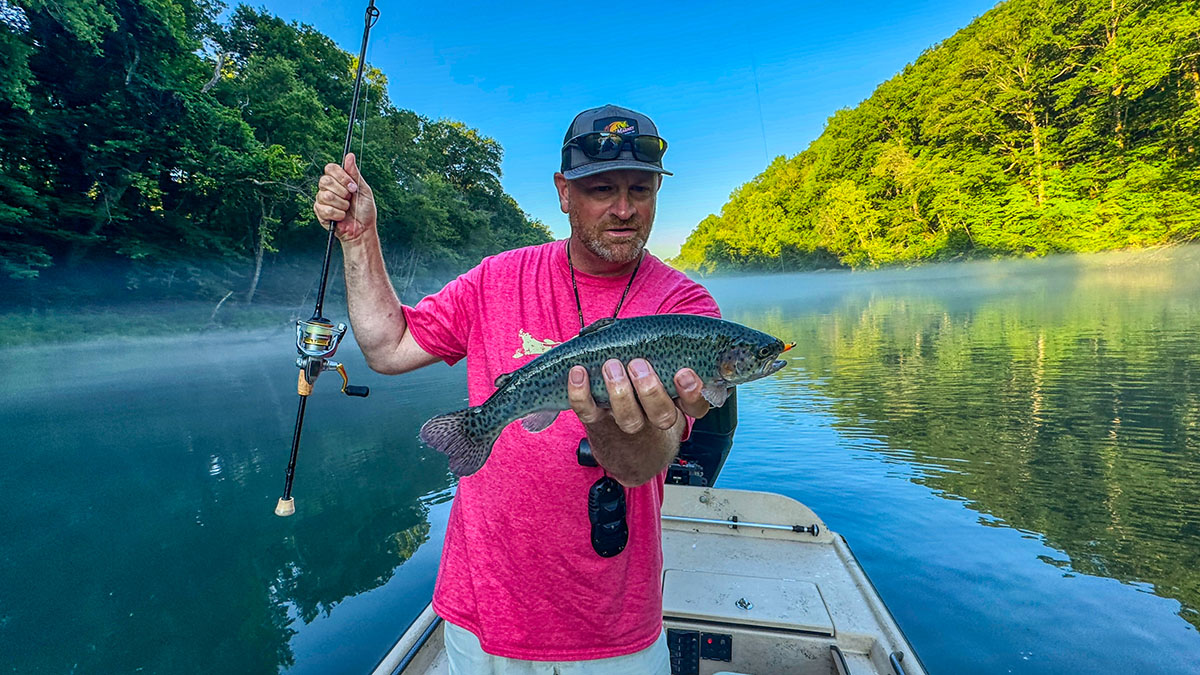
Recommended Fishing Gear for Trout Fishing
To catch trout, you don't need a wide array of artificial lures. You can keep your gear very simple and basic. And you don't have to use live bait or dough baits to be very successful catching trout.
You will often be throwing much smaller lures so you should match your gear accordingly. But again you can do it with very affordable gear. Get a 5 1/2 to 6 1/2-foot spinning rod in Light or Ultralight powers with 2 to 4-pound line.
Get a net, preferably with rubber netting so it won't hurt the fish or rough up their slime coat. Add to that a few Trout Magnets and jigheads, D2 Jigs and maybe a few E-Z Trout floats and you will be good to go to cover a large portion of the bases in trout fishing.
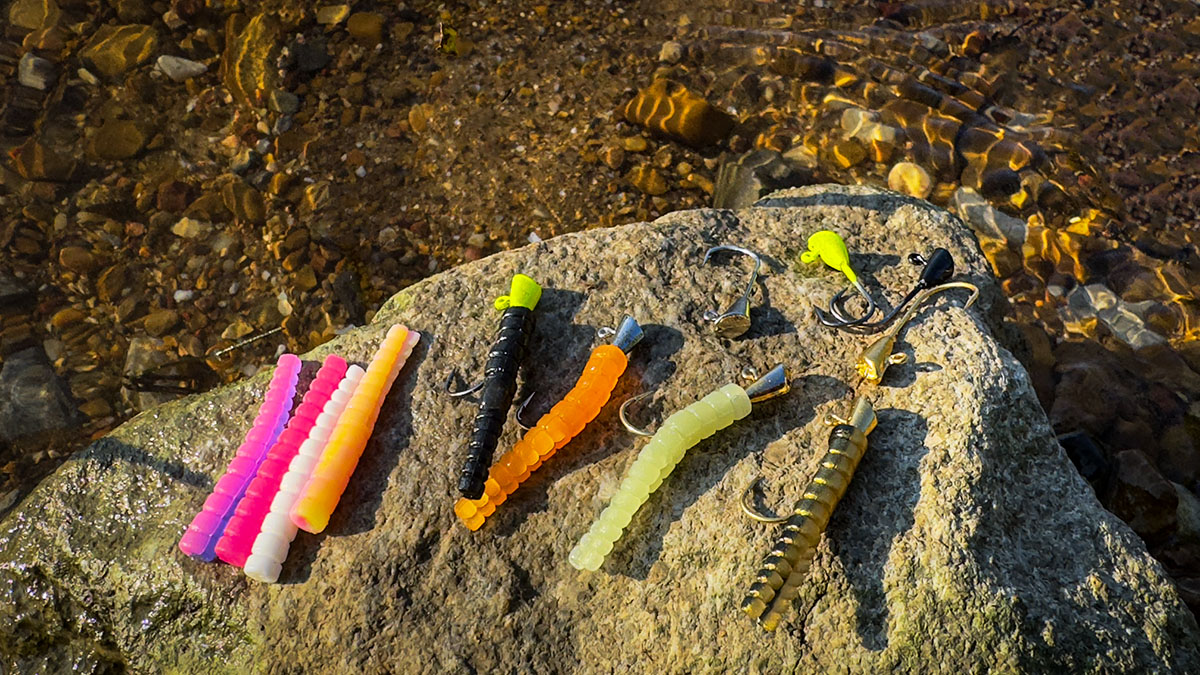
Best Lures and Techniques For Trout Fishing
Really good trout anglers recognize bait size determines the positive outcomes in trout fishing. Focusing on much smaller lures will yield much better results. Rainbow trout primarily eat bugs and may branch out into baitfish, crawfish and a bit larger offerings but a large part of their diet is simply teeny tiny bugs. A brown trout switches to baitfish a lot earlier in life and will eat larger lures, but most of the time, you are deciding on whether to use a reaction lure or a food lure.
A reaction lure is something like a crankbait, jerkbait, spoon or spinner meant to trigger a fish into reacting aggressively to something aggressive in their strike zone. A food lure would be something like a small plastic on a jighead, a hair jig or a fly that looks buggy like a naturally drifting food source to the trout.
For trout, you often want to drift close to the bottom with your lures. If you're fishing a food type lure that is almost always the case unless you are fishing shallower for fishing looking for bugs and food near the surface. Then you can work your bugs up closer to the surface. But day in day out, you are trying to keep your lure as close to the bottom without snagging while it naturally flows at the right speed with the current. This often means casting a lure and letting it drift with the current as you control your line to keep it from being pulled to fast and looking unnatural in the current.
This mending of the line is nothing more than flipping your line up behind the float or lure so it presents naturally to the fish without being drug by something ahead of it in the current unnaturally (like your line or a float).
A Trout Magnet is arguably one of the best lures to ever be poured for trout. It is a perfect profile to represent a lot of buggy things in the trout's diet while also balancing perfectly on the Trout Magnet jigheads. One of the best and easiest ways to fish it is below an E-Z Float. Simply peg the float on your line above your Trout Magnet so you can get the bait to drift downstream naturally just above the bottom.
This requires you to constantly play with the the depth or distance of your lure to the float. This do-nothing approach is simply deadly on trout. Now if you want to drift a Trout Magnet in say water 7 to 9 feet deep, then you need to employ long 8 and 9 foot spinning rods to manage your line for casting. A lot of anglers will even employ fly rods to fish these long leash Trout Magnets.
If you want to fish a bit deeper and more aggressively, you can step up to a D2 Jig. They D2 Jig is designed to be cast out and hopped back to the boat with its unique spiraling fall, it draws vicious strikes from Rainbows and Brown trout alike. You can be very aggressive with big high hops on heavier 1/8 ounce D2 jigs in deeper water. Or you can be more subtle, twitching it and hopping it a few inches in water a couple of feet deep with the small 1/16- or 1/32-ounce options.
"If I'm in a more wild environment, I'm starting with the D2 Jig," Taylor said. "If I'm fishing on a more stocked environment, I'm probably fishing the Trout Magnet first."
"For me if I'm fishing deeper, faster water, I will fish more aggressively with a D2 Jig. If I'm fishing slower, shallower water, then I'm probably going with the natural drift with a Trout Magnet," Smith said.
Cranks and jerkbaits can be effective for trout too, especially bigger trout. A more aggressive approach of ripping a jerkbait or pulling a crankbait can at times be a very good approach to finding fish. Getting trout to react out of impulse to fast movements can often lead to bigger catches and also help you find fish faster when you need to cover a lot of water to learn a new fishery. It's a great "one-two punch" in trout fishing to find active fish with aggressive lures and presentations and then slow down and offer food to them once you find the fish.
"When you find rainbows, they have buddies," Smith said. "So I might look for them with aggressive lures and tactics. But, when I find some fish, I will pick up that Trout Magnet and feed them to catch a lot more fish in an area. I'm not sitting in one area and throwing the Trout Magnet Crank or D2 Jig. I'm covering water. Then when I find them I will sit down in that area with a Trout Magnet and catch a lot more with a feeding presentation."
For small streams, especially natural streams that have a natural forage base of crawfish, a Trout Slayer can be a deadly weapon. Just hopping and bumping it along the bottom will produce a lot of trout as well as other species that may also frequent those waters like smallmouth bass, panfish and more. It's a great choice when fishing spring fed and natural small streams.
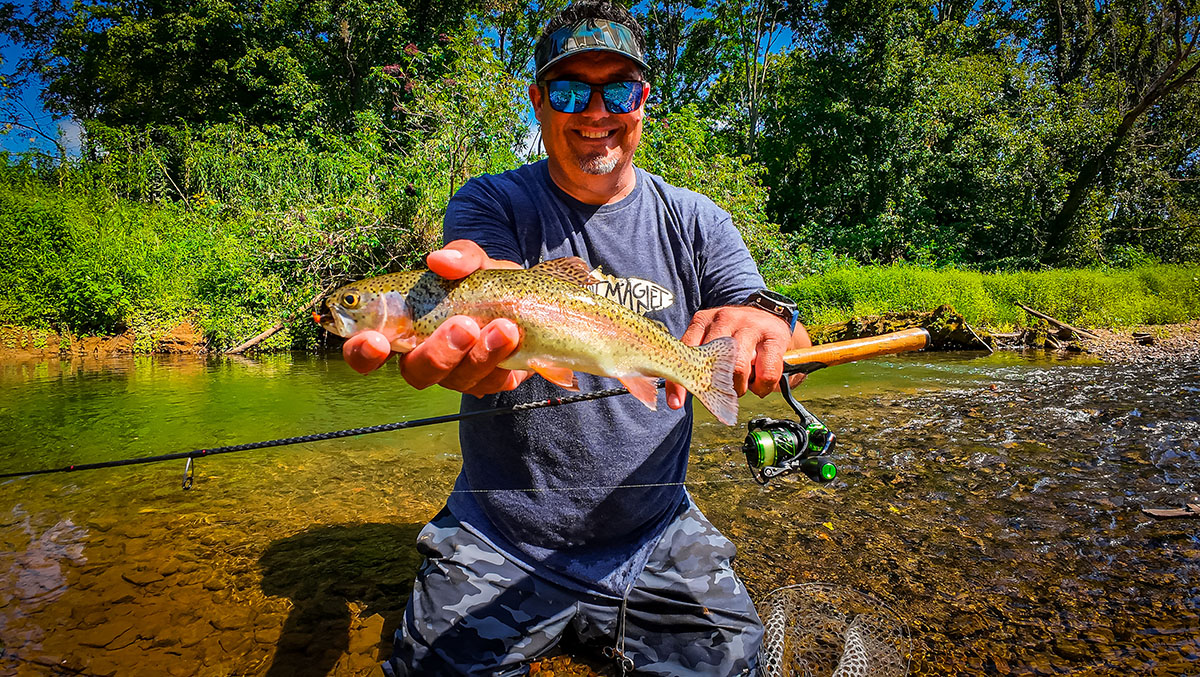
Other Things You Should Know About Trout Fishing
There is too much nuance about trout fishing to cover it all in one article, but you should realize by now that you can make trout fishing very simple with a systematic approach to catch a whole lot more fish.
Often Taylor and Smith will simplify their fishing like this: They work downstream spin fishing for stocked trout, but will often work upstream fishing for wild fish. Regardless of the type of fishery you fish, keep in mind some of these other basic guidelines.
Use light gear and smaller lures to be more effective and present more natural presentations. Using 6-pound line will greatly inhibit your lure's natural drag in the water compared to 2-pound line. And both Taylor and Smith have landed fish over 10 pounds on 2-pound line.
If you fish on foot a lot, darker clothes can help a lot to hide your silhouette to the fish. You're often fishing for trout in gin clear waters and you need every advantage you can get.
Don't be afraid to drift your Trout Magnet downstream. Let out line and control your drag on the water and feed line downstream to fish. It can be a deadly tactic that lets you fish water before you go over it if working downstream.
Remember trout are opportunists. They want to sit in the water without having to work too hard and watch the food wash by. So they want to be close to the current without spending all day in it. So look for seams, bends, pocket water, depth changes and obstacles to find likely fish holding spots on your waters.
Keep the fish in the water as much as possible. A good net will help make this easy. Handle them gently and unhook them quickly. Holding a trout upside down will often calm them and make them a little easier to unhook. A pair of forceps are invaluable to a trout angler to get fish unhooked quickly and harmlessly. A pair of snips can be very handy to for quick reties and lure changes.
Use reaction lures to find fish and food lures to catch multiples in single areas. Arm yourself with some Trout Magnets, D2 Jigs, Trout Cranks and Trout Slayers. On the Trout Magnet side go with your louder brighter colors as "unnatural colors presented naturally seem to always attract more rainbow trout."
On D2 Jigs, get a couple dark colors and couple light colors in a couple different sizes to cover the bases. Get some 2-pound SOS Trout line, some 2 pound fluorocarbon Phantom Leader and a light action rod, and you will be surprised how many trout you will catch in quick order.
